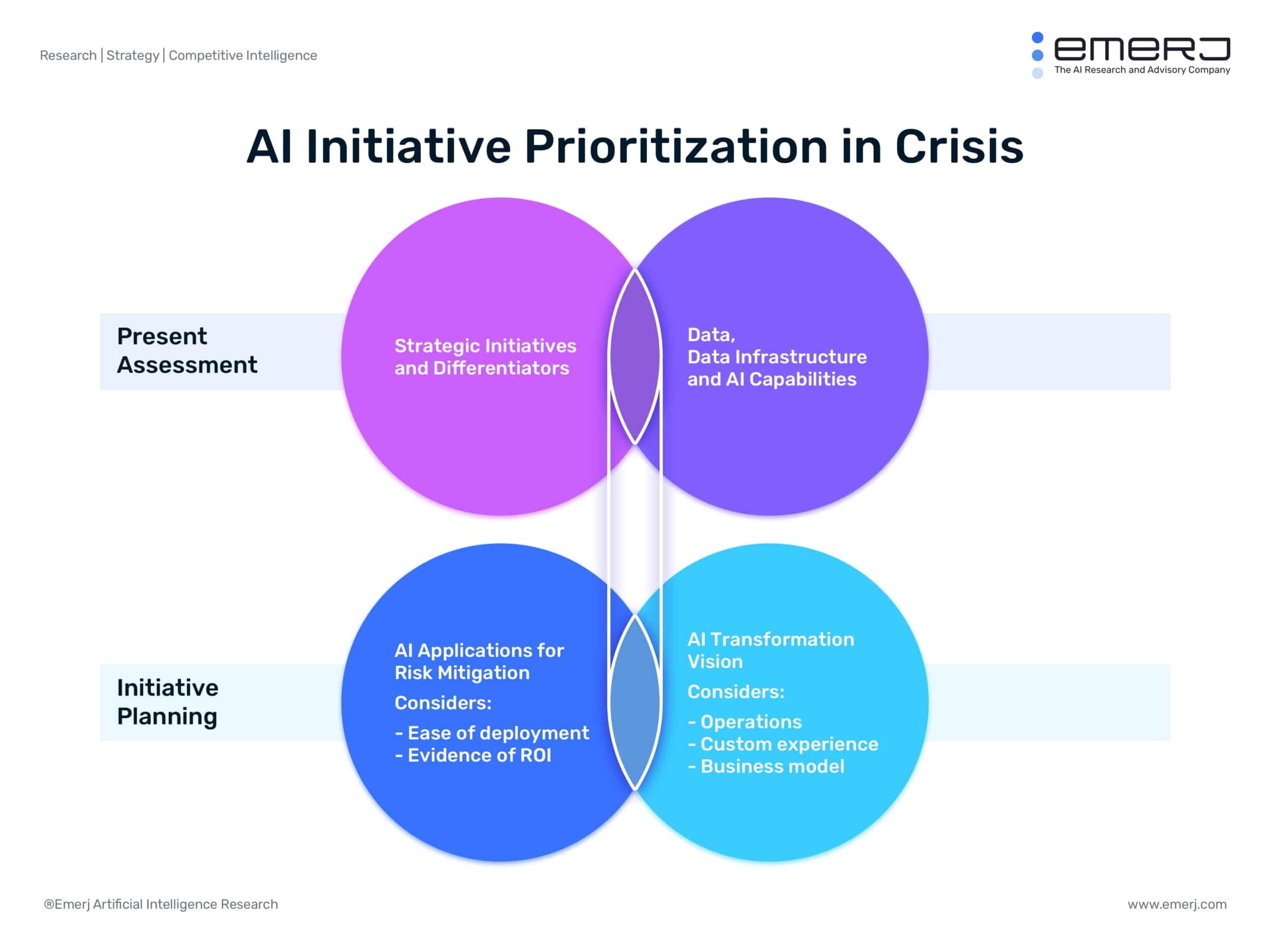At Emerj, our research involves tracking AI and innovation across industries, dialing into where AI is driving ROI, which we do through our AI Opportunity Landscape research. In these hard times, we’re expecting many AI startups to fade away and many technology priorities within large enterprises to completely shift to be more in line with what we’re going to be articulating in this article.
The model below illustrates how leaders might reassess their AI initiatives:

Strategy Reassessment – Firms who respond well to this crisis from a standpoint of AI applications and projects will first have to assess their current strategies. In this time of crisis, all strategies are being re-assessed, and what was yesterday a differentiator or a key thrust of the next two years may fall by the wayside. New priorities and key thrusts must be determined and agreed upon.
AI involves too much fundamental change to apply it haphazardly to non-priority areas of a business – AI is an investment that will (especially in times of great disruption) involve ardent focus, and focus must be aligned with strategy.
AI Readiness (Data Infra, etc) – Once the strategy has been redrawn – at least at a tertiary level – leadership can get a sense of where they stand in terms of AI readiness around their most important data.
This could involve assessing the accessibility or harmonization of their payment fraud data, or the number of in-house data scientists who have experience with marketing data, etc (read more about AI readiness in our article Critical Capabilities – Prerequisites to AI Deployment).
In the Venn diagram above, the strategy and readiness circles overlap. This is because assessing enterprise-wide AI readiness is unlikely, particularly in a time of crisis. Rather, firms need to determine their strategic priorities, and determine their readiness as it pertains to these key thrusts that will already be receiving attention and funds.
Once a firm has an understanding of their strategy and readiness, they can move to consider AI initiatives and projects. There will be two major business priorities that take precedence during the pandemic:
- Risk Mitigation – Handling immediate, pressing problem – putting in place defensive measures to prevent additional harm to the organization in a time of disruption.
- AI Transformation / Business Evolution – Determining new ways to operate, or new ways to serve customers – positioning the firm to gain market share and growth into the future.
Just as with the first Venn diagram, a firm should be looking for AI applications that aren’t merely defensive, but that offer promise for future advantage.
The art and science of combining near-term defense with long-term offense will have to be the topic for another article – and is the focus of much of our work with enterprises. In this article, we’ll take a look at examples of both kinds of AI initiatives (risk, and transformation) to help leaders think through what applications might be relevant for them.
Risk Mitigation
Most companies will want to focus on keeping themselves afloat during the coronavirus pandemic. This may put a lot of other initiatives on hold and bring any kind of risk reduction to the forefront of the businesses. This has consequences for both artificial intelligence startups and established enterprises.
Startups
AI startups will need to tie their value proposition to immediate problems. They’ll need to talk to their customers and determine the critical problems that are absolutely most dire for them. Startups may need to pivot their technology offering or the way they deliver their service based on these new needs.
Some companies will need to pivot and sell to entirely different businesses or departments, perhaps even different markets, if they can’t find a strong match for immediate problems.
Enterprises don’t want to do business with AI startup companies simply to solve an existing problem. They’d rather go with an established vendor for identifying and handling a known problem.
But AI startups have the advantage of being companies that enterprises believe will help drive success into the future. So it’s important for companies that change or reframe their offering to also frame their offering not just as a bandaid for today’s problem, but as a new foundation and a new path forward for adjusting to a new way of business.
Startups have to ask themselves:
- How are the industries that I’m selling into going to fundamentally change?
- What will be the new normal within the businesses that I’m selling to?
- How can we help to accelerate an advantage for the people who depend on our technologies versus those of our competitors?
Not all vendors are going to be able to reframe their offerings as something that actually helps with immediate problems. For some of those companies, that’s going to be the end of the road.
For other companies, it’s going to mean they’re going to be spending a lot of 2020, simply planting the seeds for much longer-term future sales that may not come immediately.
They may be looking at a much longer cycle to sale. If their value proposition is entirely based on creating a roadmap to the future and they’re unable to appeal to the value of fixing immediate problems, they may need to get lean and focus on long-term seeds that will blossom into sales when companies can actually think about something other than the coronavirus pandemic.
Enterprises
For enterprises leveraging AI, they’ll be looking for low hanging-fruit more than ever.
The simplest risk mitigation applications are those that can take a limited number of initial data sources that are already reasonably harmonized and detect anomalies in that data in a meaningful way that allows companies to save money.
For example, there are some problems within the logistics industry around predicting inventory that may require disparate sources of data about the transportation of goods, the storage of goods, different kinds of products and items being stored in different locations, as well as inventory data.
Being able to merge and harmonize all of those different kinds of data to find patterns between them all requires a tremendous amount of digital transformation that most companies simply haven’t done.
Low-Hanging Fruit: Friendly Fraud Detection
Friendly fraud refers to when a customer purchases something and then claims that it was made as a fraudulent payment so that they can keep the product and get their money back. Detecting this involves a relatively simple set of data that’s already in some kind of digital format.
So long as a company records what someone bought, how they purchased it, who actually purchased it, and how long it was later that they issued a chargeback, the company is likely able to detect the fraudulent activity.
As a result, companies are better able to not only prevent high risk payments from coming through in the first place, but also from successfully defending and reducing chargebacks altogether by simply detecting patterns in an already digitized set of data.
Ayasdi is a prominent AI vendor that has been working on this problem since the early 2010s. Below is a video that explains how the company visualizes friendly fraud transactions and how this allows companies to pick up on factors that may reveal transactions to be friendly fraud:
It certainly isn’t “plug-and-play” easy, but it’s a much simpler risk reduction application. We expect these low-hanging fruit anomaly detection and pattern recognition problems in different corners of the enterprise to be where a lot of the action is in AI at this time.
Business Evolution
While many companies will exclusively focus on reducing risk while dealing with the crisis, many businesses that are seeing their supply chains, and customers’ needs changing drastically will need to think about business evolution and how to come out of this crisis. This is because for the vast majority of businesses, this isn’t business as usual.
The Evolution of Retail in the Coronavirus Era
For example, retail firms will have to pivot to eCommece as long as the world remains in quarantine. They may focus on building or improving a recommendation engine to help their online shoppers find items they like and increase cart value.
They may also focus on improving their digital marketing with AI. Some AI vendors offer software that can suggest site layout changes automatically to improve brand loyalty and conversion rate, such as Evolv. For more on that particular type of application, listen to our interview with Evolv’s CTO on our AI in Business podcast.
The Evolution of Financial Services in the Coronavirus Era
Financial services companies may very well pivot to improving the customer experience because people are unlikely to be walking into their local branch at this time. Chatbots might be one way they attempt to solve this problem, especially because many of the top banks and financial institutions have put out press releases about their own chatbots over the last few years.
However, Emerj’s AI Opportunity Landscape research shows that chatbots in financial services are, for the most part, very unlikely to generate an ROI: As of 2019, chabots made up approximately 49% of the AI products at large financial institutions, but only 5.5% of the AI-related venture funding in the financial services industry.
This indicates that although large financial institutions are talking about chatbots often, they and venture capitalists that know the industry aren’t putting their money in conversational interfaces.
This may change as financial services customers’ needs shift in response to the virus, but regardless, customer service is likely where financial services institutions will be looking to focus. If not chatbots, they might look into call center automation.
The Evolution of Logistics in the Coronavirus Era
Logistics firms will double down on prediction, although it may be difficult to start collecting the data for such an AI project in such an anomalous and uncertain time. Logistics companies that are already using some kind of predictive technology or have been collecting digital data on their costs, lead times, and other factors may be able to leverage predictive analytics software.
Approximately 23% of the AI vendors in logistics offer products for supply chain risk management, which may be imperative for planning for the next pandemic or national emergency.
Similarly, 28% of AI vendors in logistics offer products for supply and demand prediction, which also account for 19% of the AI-related funding in the sector. Such an application may be more immediately important as customer buying behavior fluctuates during this time.
A Time for Nontechnical Professionals to Lead AI Efforts
During this crisis, there will probably be more data scientists (from the startup ecosystem) entering the workforce than ever.
For the first time, the Masters and PhD AI graduates from top schools may not be getting unlimited job offers for large sums of money as soon as they graduate.
While plenty of this new talent will still end up working for big tech, much of it will also blend into the workforce of enterprises as part of innovation and resiliency efforts.
Nontechnical leaders will be the ones that actually steer their business through the storm. It will be functional business leaders, heads of innovation and strategy and heads of different departments, who play the most important role in navigating their unique business context and determining the important innovation areas on which to double down in order to to come out on the other side of the coronavirus pandemic with greater market share and a better foundation than before.



















